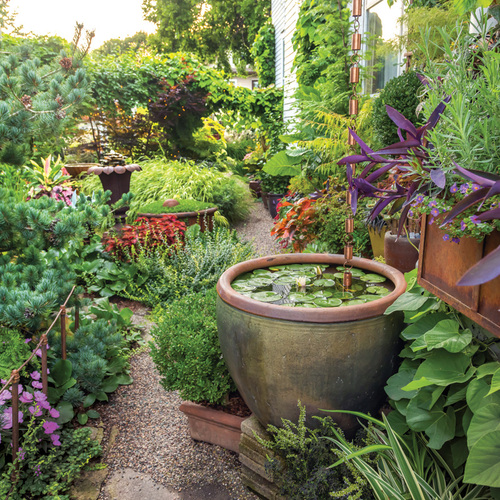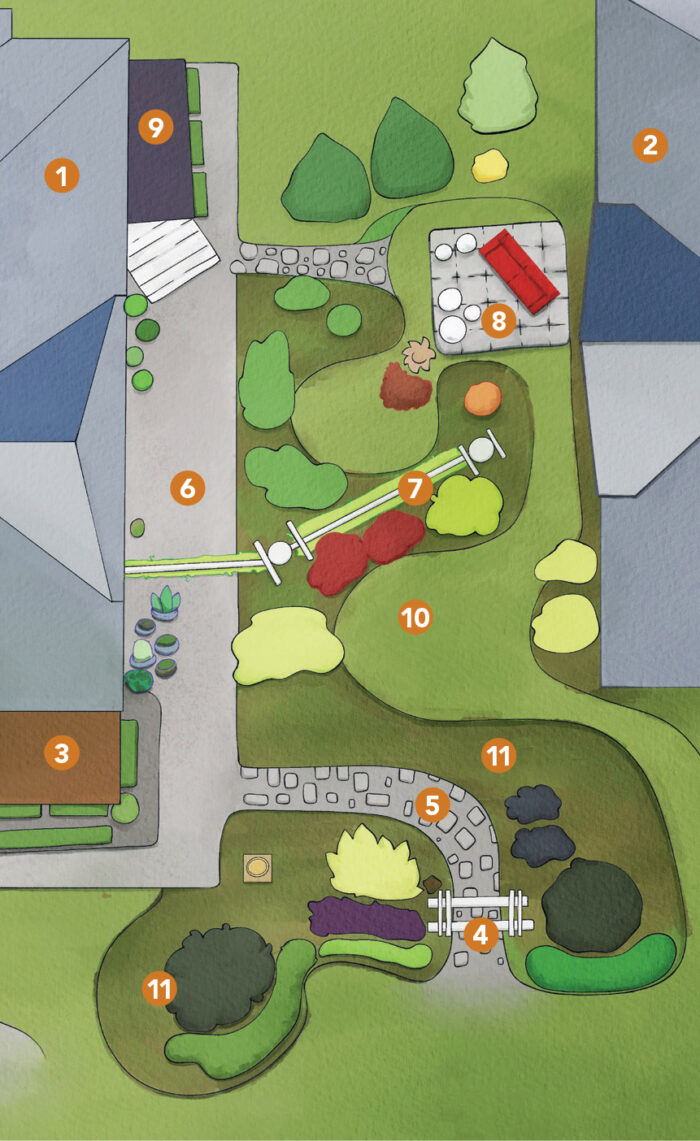A narrow strip of forgotten lawn was all I could see out of my apartment when I moved into a Victorian-era Minneapolis home more than 25 years ago. The yard was half-shaded by a wayward red mulberry tree (Morus rubra, Zones 5–9) and grew only sparse grass; it seemed that its only purpose was to inspire my creativity. I had little money but plenty of time and vision. Because I was a renter, I asked my landlady’s permission to make changes to the space, and she enthusiastically agreed.
Learn More:
Maintaining Privacy Without the Fence
Effectively Grow Tropicals in Cool Climates
Utilize What You Have
I soon discovered a pair of vintage porch columns in the basement; they became the posts for an arbor and lintel, which I erected halfway down the side yard and are now covered in vines in the summer months. With this structure in place, the once-vacant area felt immediately connected to the house. I then installed a small patio and began to contemplate bed lines by simply laying down my garden hose. While establishing the garden, I was often working with plants and materials I could get cheaply or for free, such as granite cobblestones that came from a local street-renovation project. These were used to form a walkway under another arbor that became the entrance to the garden (photo above). Over time, I’ve become more conscious of my intentions for my small space.
I have selectively edited most of those original freebies and finds, replacing them with more desirable selections that looked and performed better together. Focusing on plants that play off each other’s colors, among other features, became paramount to maximizing interest, and adding dozens of containers allowed for many more plants than I would otherwise be able to accommodate in such a compact area. Finally, it was important to maintain a living space, allowing myself and any visitors to fully immerse themselves in this hidden escape in the middle of an urban environment. Today, the result of these design tactics is a small landscape with big impact.
Strong Plant Pairings in Vivid Hues Set the Scene
Passersby are immediately confronted by a wave of contrasting textures and colors that accentuate an arbor and cobblestone path leading to the backyard. Most prominently, purple heart tradescantia’s deep coloration is drawn out from the lighter hues of Tropicanna® Gold cannas and a ‘Golden Teardrop’ sedum (Sedum lineare ‘Golden Teardrop’, Zones 3–9) (below).
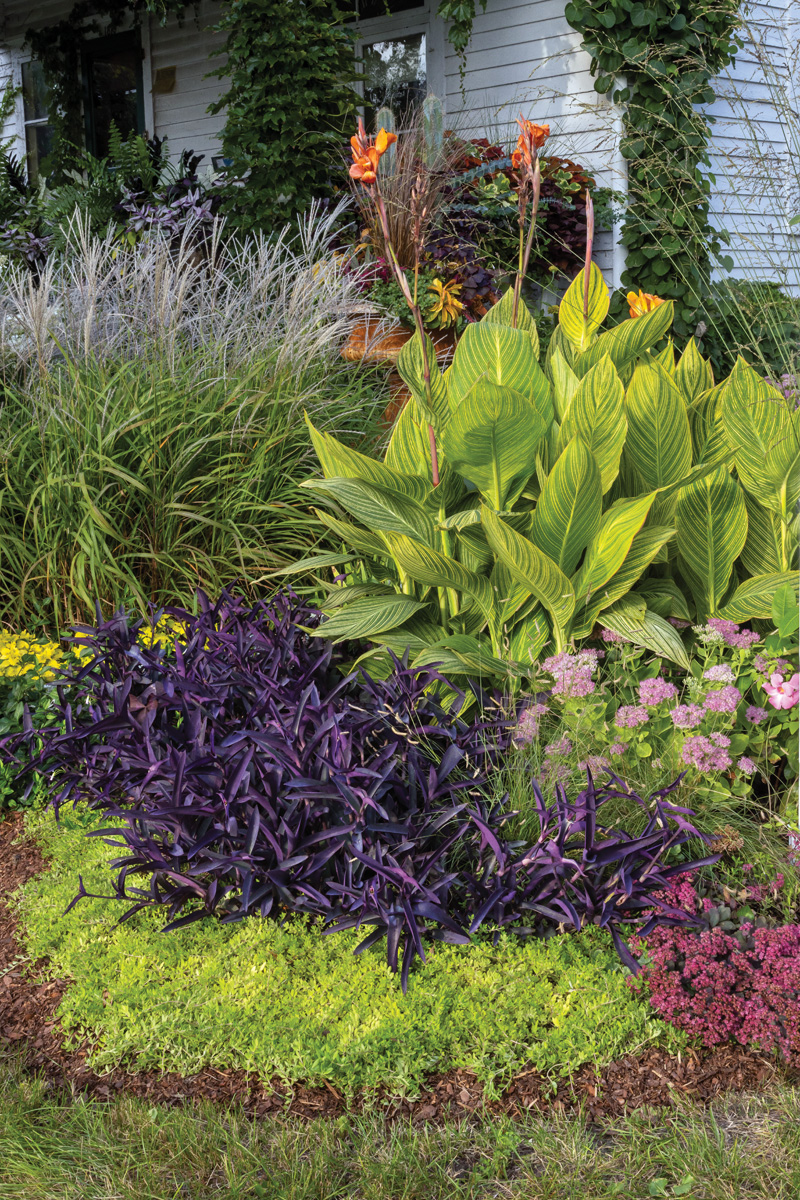
Emphasize Bold Forms and Textures with Proportion and Contrast
It’s not that I dislike plants with showy or prominent flowers, but in my garden, it’s all about foliage. The leaves of a plant put on a display every day of the gardening season, not just when the plant is blooming. I collect plants with foliage I adore and then locate them in contrast to one another.
Color is not the only factor to consider when it comes to contrast. Texture, habit, size, and shape can be just as important, especially when it comes to green foliage. I keep this in mind whenever I marry selections together, starting with the first pairing you see; in spring, I plant drifts of Tropicanna® Gold cannas (Canna indica ‘Mactro’, Zones 7–11) and purple heart tradescantia (Tradescantia pallida ‘Purpurea’, Zones 10–11) in my front garden beds (above). Their bold leaf forms and strong, distinct colors of chartreuse and deep indigo pair nicely with the fine-textured, majestic perennial grasses that rocket upward nearby by midsummer.
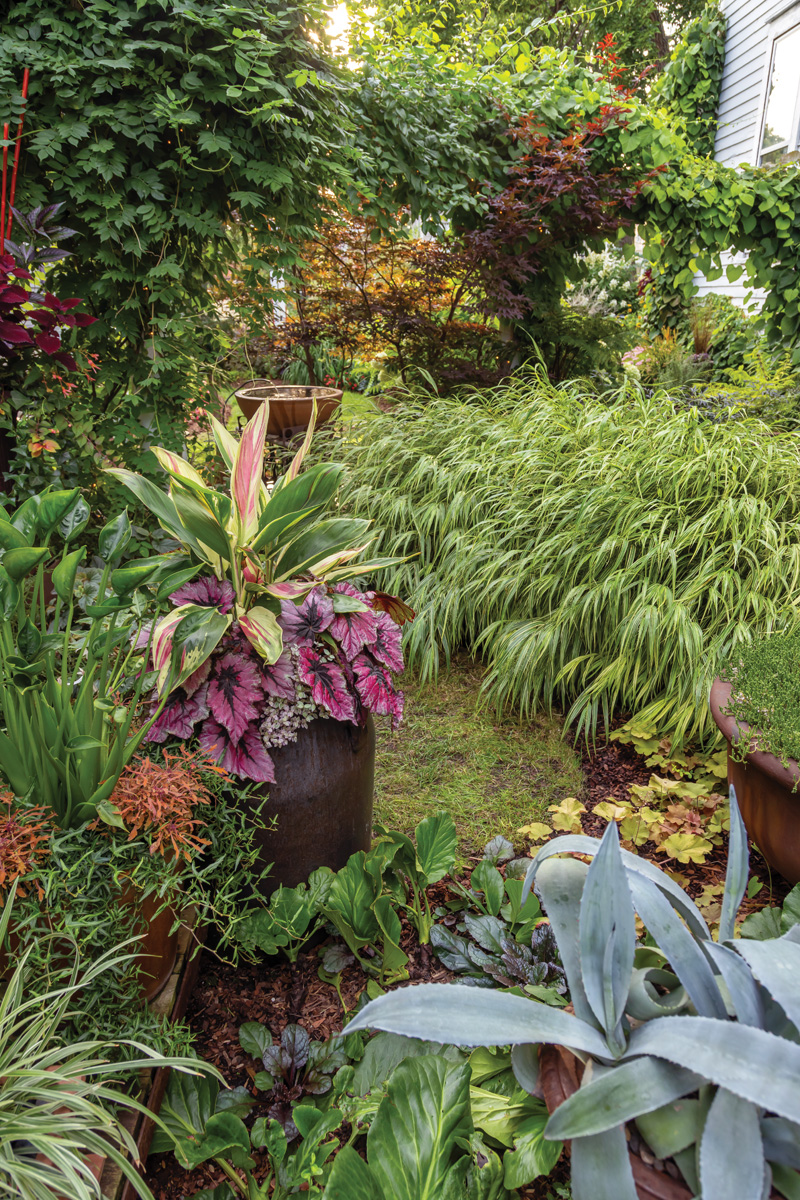
| Key Garden Elements |What: Urban side yard in Minneapolis, MN Zone: 5 Size: 20 feet wide and 60 feet long Conditions: Rich, loamy soil; mostly shade with some small areas of sun Challenges: Rabbits and squirrels; wind; proximity to street and neighbors |
|
| 1. Derrik’s house
2. Neighbors’ house 3. Front porch 4. Arbor entry to garden 5. Granite cobblestone path 6. Pea gravel pathway |
7. Arbor and lintel with vines 8. Patio and outdoor sofa 9. Back porch 10. Lawn path 11. Planting beds |
|
|
|
Space-Conscious Combos Help Divvy Up Precious Real Estate in a Small Garden
Small ‘Emperor I’ Japanese maples, with their vertical habit and dark leaves, help distinguish nearby drifts of Japanese forest grass from a sea of green. The contrast allows this perennial to have a greater impact with its relatively large spread. Pops of color and bold forms in nearby pots add additional interest.
Once I land on a stellar plant pairing, I also think about the proportion and shape I want the plants to occupy in the landscape or container. This is especially of concern in a small garden, where space comes at a premium. For example, I love Japanese forest grass (Hakonechloa macra, Zones 5–9) for its fine texture and brightly colored blades and wanted a proportionately large swath of it to really accentuate its horizontal movement. But I found that a couplet of relatively small ‘Emperor 1’ Japanese maples (Acer palmatum ‘Emperor 1’, Zones 5–9) were all that was needed to punctuate that statement with their dusky satin-purple foliage (below). Together, they make a dynamic pairing. Directly underneath the trees themselves, a sea of various ground covers grows in contrasting shades. This combination gets more spectacular in autumn, when the maples blaze neon over the cool greens. For me, this is a bold pairing with pleasing proportions in all seasons.
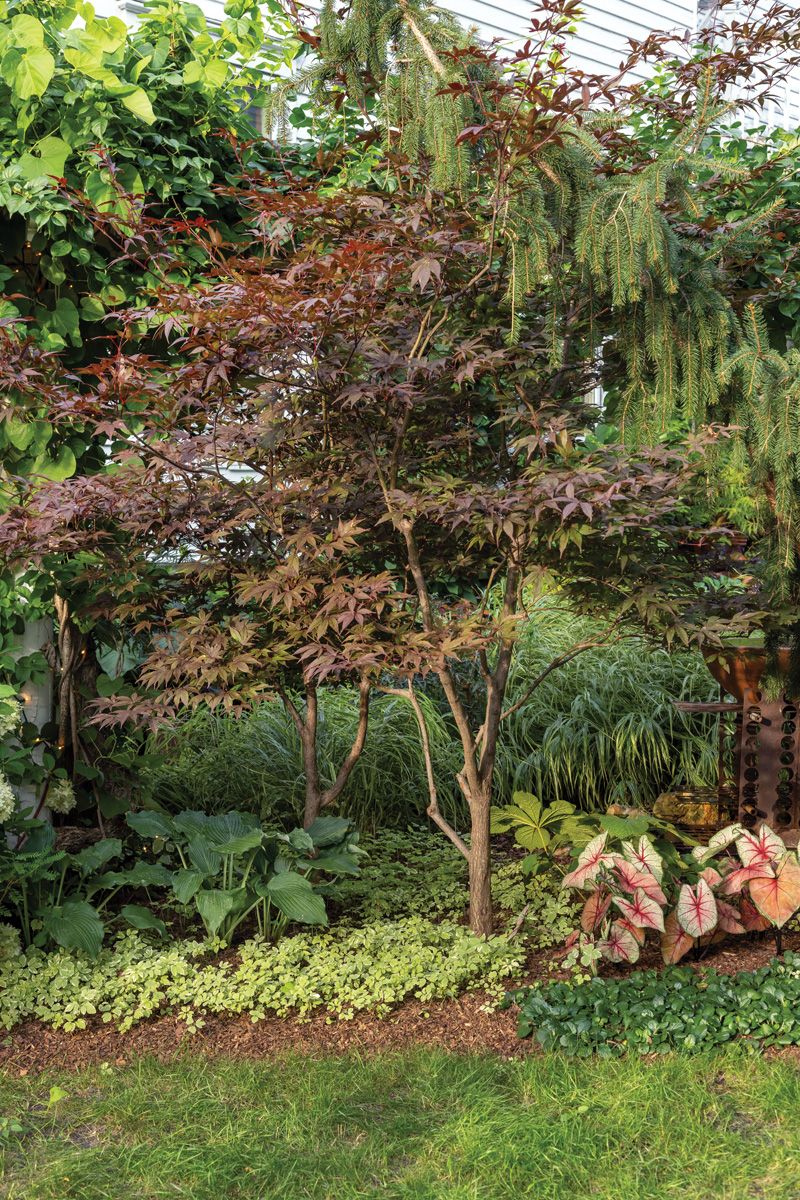
Make Size Seem Relative Through Careful Placements
Playing with proportion and scale in addition to color and texture adds an extra layer of intrigue to any combination. ‘Emperor 1’ Japanese maples (above) and elephant’s ears (below) both loom larger than life over much smaller nearby companions.
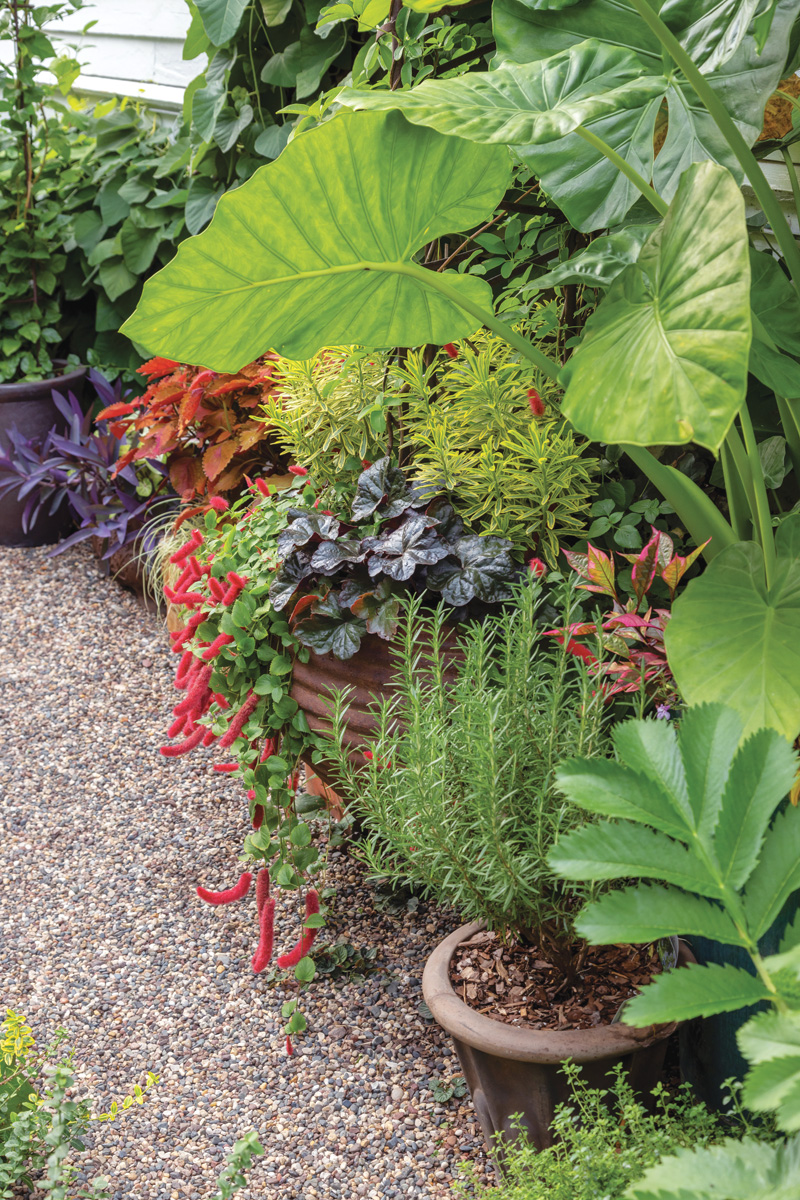
Containers can also add a touch of contrast. Not only do their rustic and refined finishes show up wonderfully against the foliage of nearly any plant, but they can be located wherever their size is most effective in emphasizing surrounding forms and textures. The plants paired with them also play a role. I use many larger tropical foliages to achieve scale in pots, especially elephant’s ears (Alocasia spp. and cvs., Zones 9–11; Colocasia, spp. and cvs., Zones 8–11) and caladiums (Caladium spp. and cvs., Zones 9–11). It is astonishing the effect that lumbering, umbrella-sized leaves have when placed above something like a small ‘Blackout’ heuchera (Heuchera ‘Blackout’, Zones 4–9). They look even larger than they really are and make the perennials below seem even smaller.
Utilize Container Groupings Within a Limited Space to Create a Design in Miniature
When I ran out of room, I started collecting containers. Because I work in a retail garden center, I am blessed to be able to requisition imperfect pots. With a bit of Gorilla Glue, several discarded vessels now have a home, and I use upward of 80 containers every year. Not only do they increase my planting space, but they give the garden visual weight and solidity.
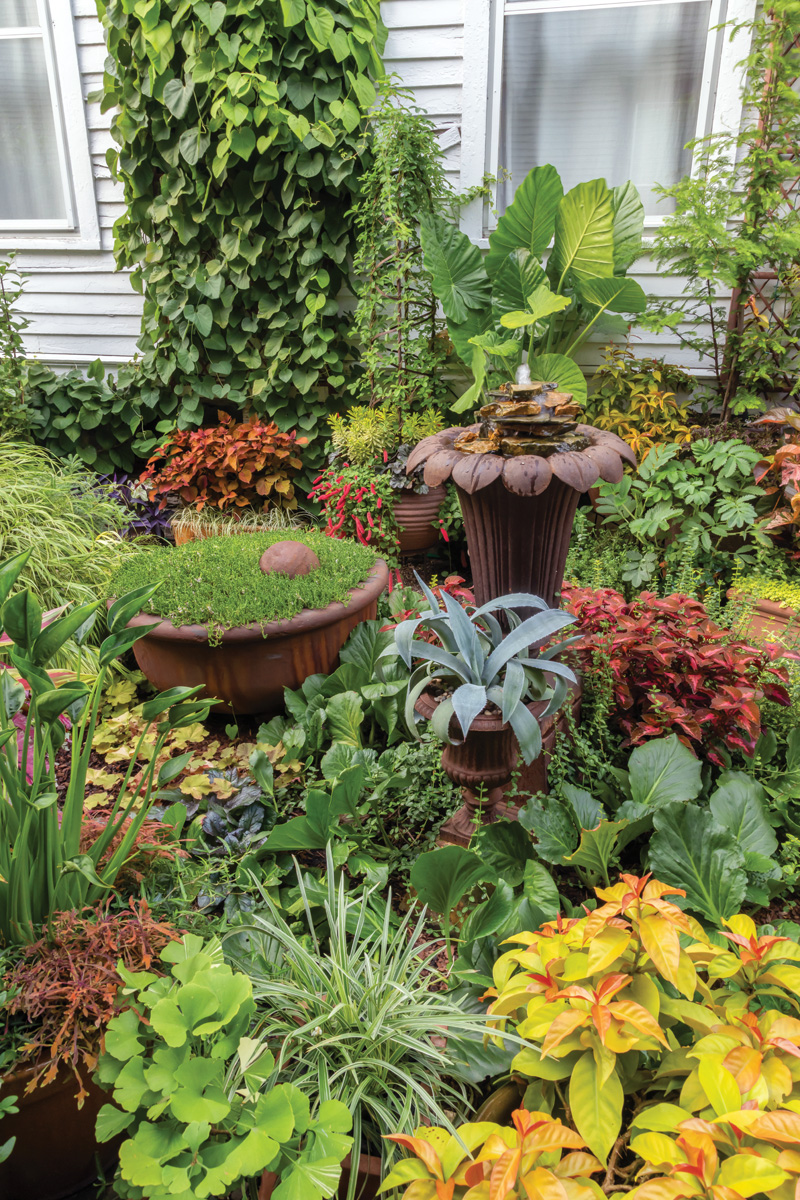
A Place for Every Pot
In order for this compact space to hold my plethora of containers, I have found it essential to place them strategically. Each spring, I uncover the pots and spend days in arranging and rearranging mode. I’m looking for placements that feel fresh and new—different than last year—yet balanced and full of opportunities for exciting plant combinations that will guide you through the garden as you walk down the paths. I first group my pots together, often in units of two, three, or five. As I would when designing with plants, I then arrange the containers by similarities or contrasting characteristics, such as color or material, like glazed ironstone or hypertufa.
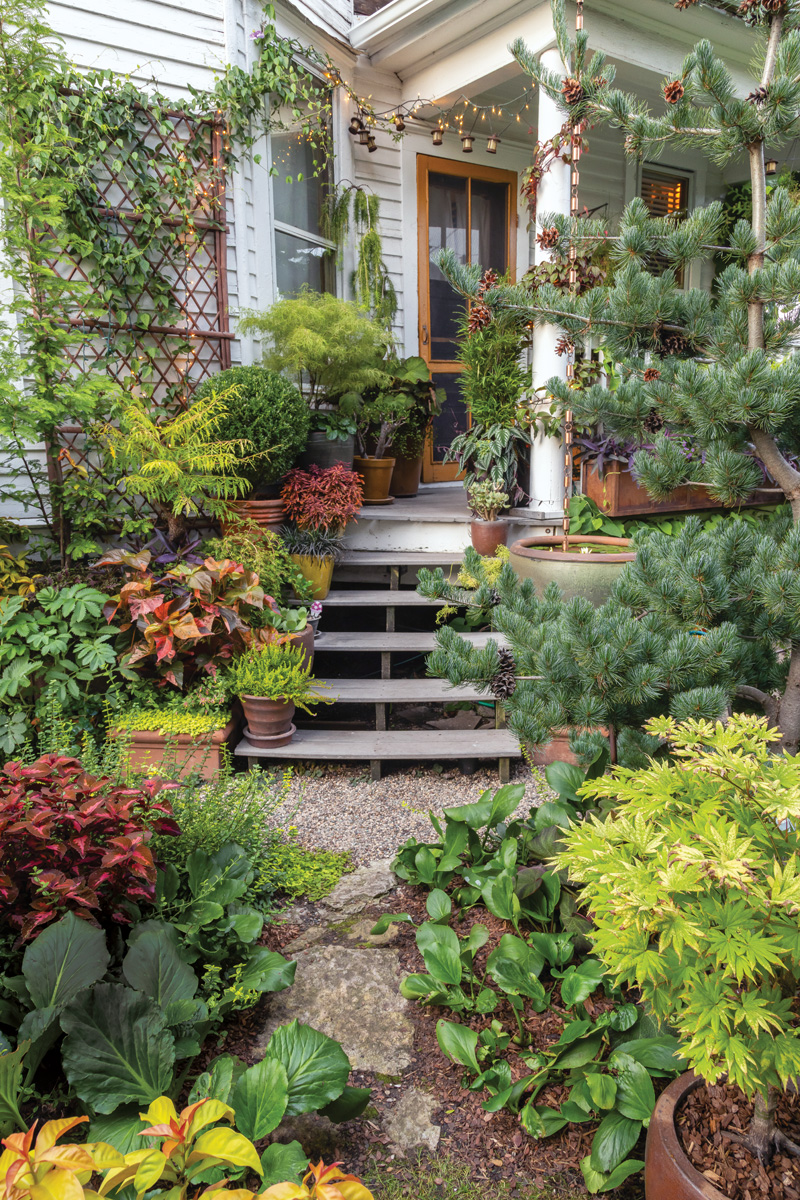
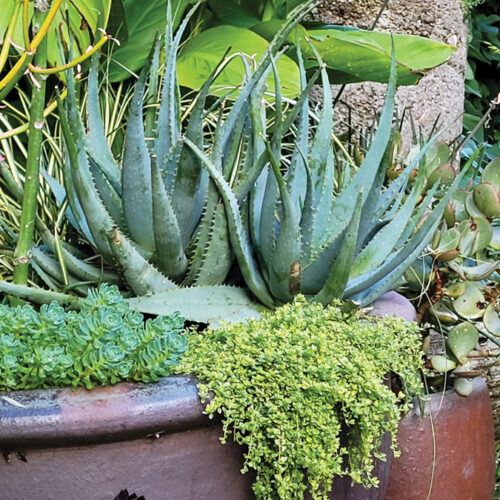
Then I consider what to add to each pot. In general, I either put a single plant in one pot and group several of the pots together, or I install a larger stand-alone mixed container. When I plant a grouping of pots, it becomes a complete design unit in miniature. I arrange the single-plant pots in a pleasing configuration, with specimens like variegated lilyturf (Liriope muscari ‘Variegata’, Zones 5–10) and ‘Peve Maribo’ dwarf variegated gingko tree (Ginkgo biloba ‘Peve Maribo’, Zones 3–9) next to ‘Godseffiana’ Barbados gooseberry (Pereskia aculeata ‘Godseffiana’, Zones 9–11), a rare cactus with golden leaves instead of spines. These single-plant pots grouped together in a design are considerably easier to create than several mixed containers. I also find these units are much easier on the eyes and add less complexity to my small space.
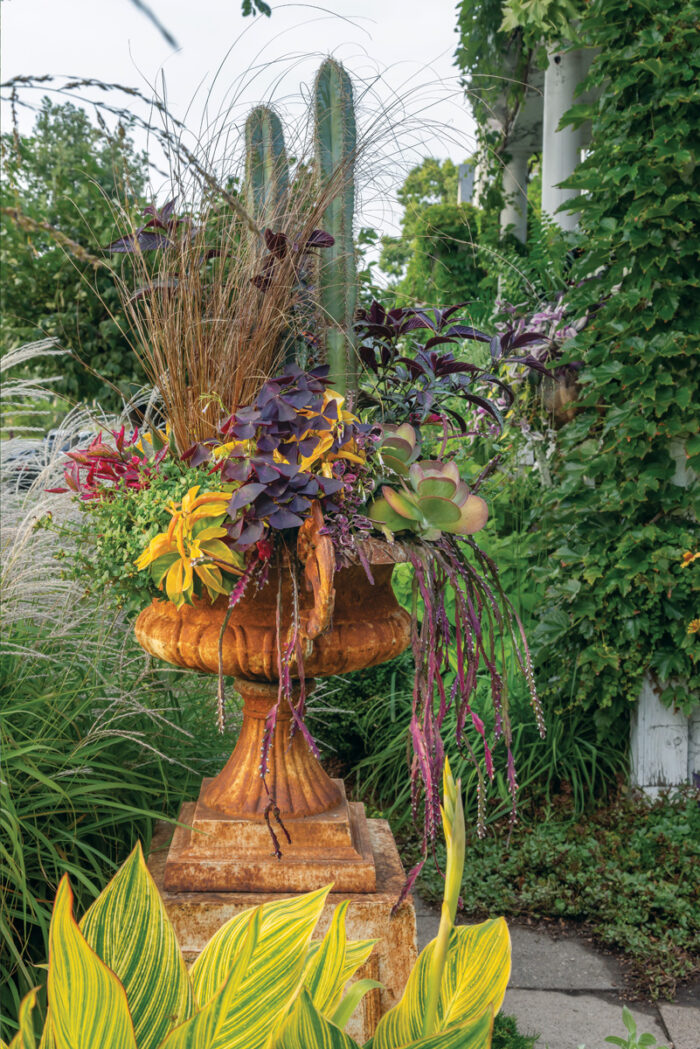
Throughout the garden, I alternate these groupings with limited mixed-container plantings. In these creations, I am mindful in choosing plants that won’t clash with in-ground neighbors so that things don’t get too messy. I have learned when contemplating these complex plant medleys to toss in all my options, then consider the context and remove what doesn’t work.
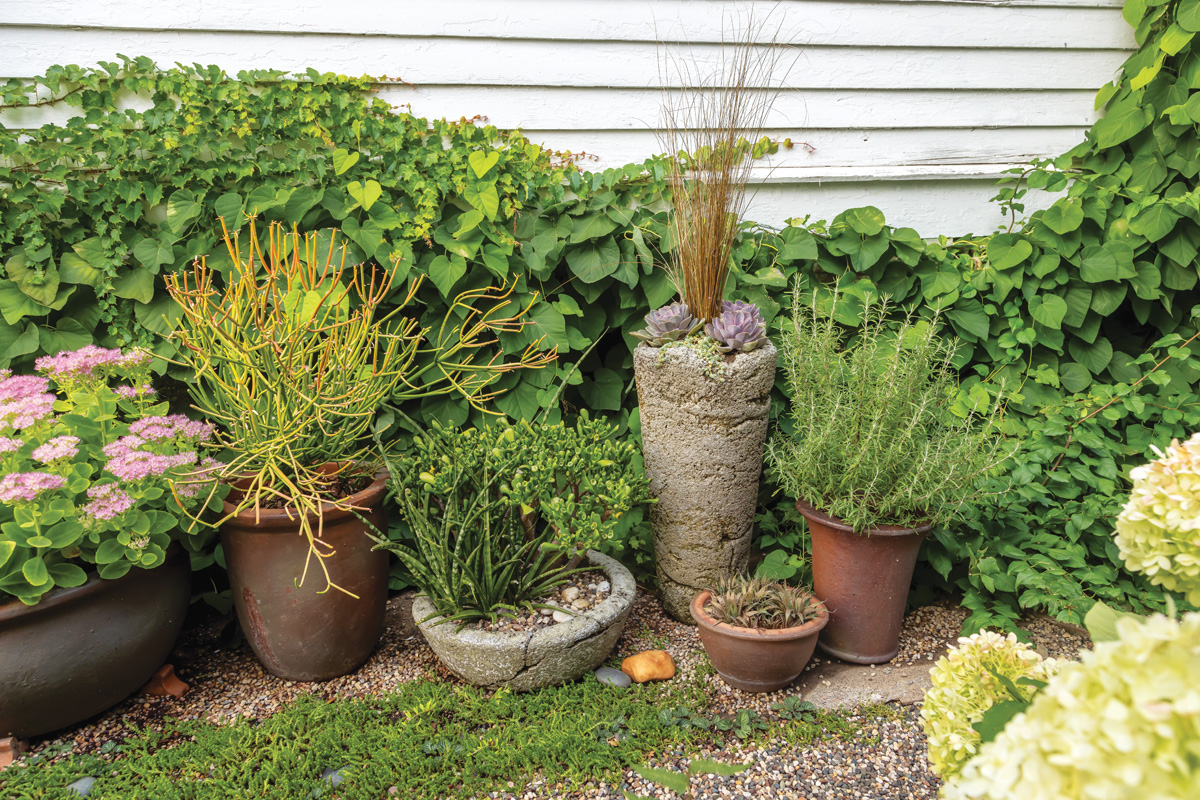
Through this process, I have found that sometimes the right plant pairing can elevate the most common of plants, like a humble American agave (Agave americana, Zones 8–11) to a superstar. Together, my collection of dozens of containers guides visitors through the space, allows me to radically change the design from year to year, and accentuates my perennial plantings that live in the ground.
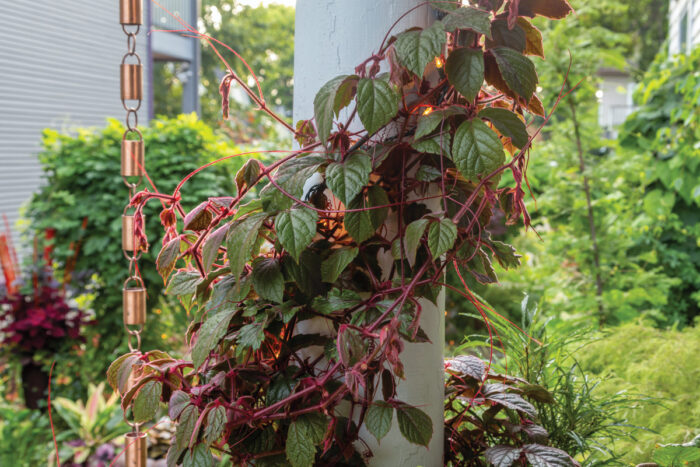
Make a Small Space Livable Through Privacy, a Tranquil Atmosphere, and Spots for Rest
Can one have it all in a small space? Definitely. While I have a largely untouched front lawn, the garden itself is a mere 1,200-square-foot slice of a bustling city neighborhood. Without much forethought, I was able to achieve everything I wanted in my miniature space—except for more space!
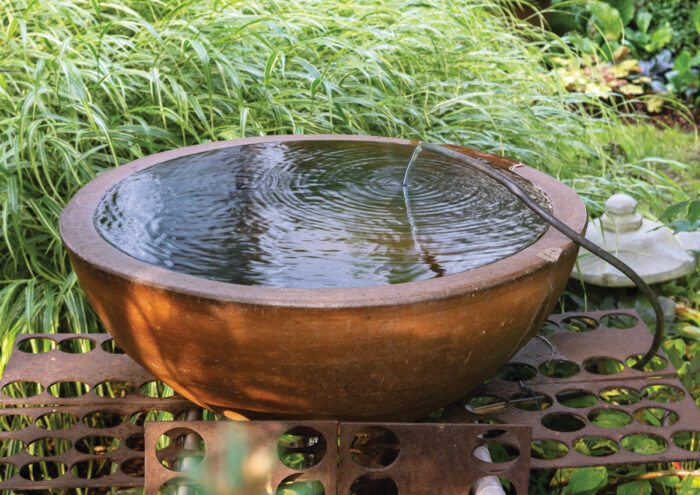
The tiny 16-square-foot patio at one time held a picnic table, but that area was sacrificed for plants. However, that doesn’t mean it’s not still functional. A short sofa rests there now, surrounded by an accumulation of plants (photo below). It is a fine spot to spend a moment. Several small water features made of cast iron and ceramic are all nestled within the garden beds to save space, and their mingling melodies muffle the urban hullabaloo nicely. The lawn in the garden is so minimal that I cut sections of it with scissors because a mower would make a mess. Grass was never a priority to me, but along the way I realized the value of a few small pieces of green for the eye to rest, so I chose to keep this precious asset. It now forms an additional path to the back garden.
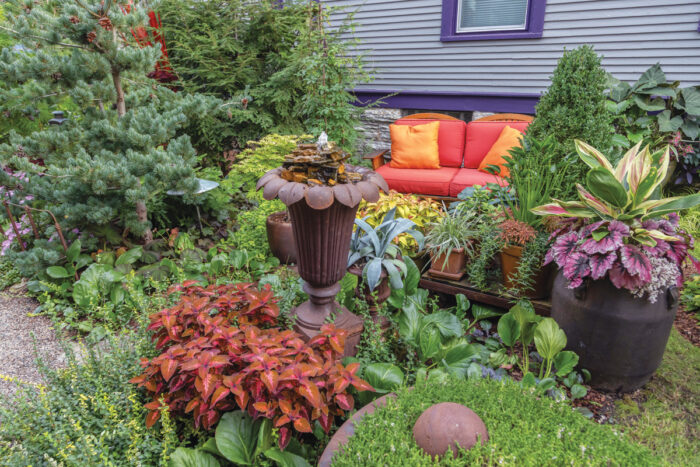
I was able to seclude my sanctuary with careful placement of a few arbor structures. An unadorned white arbor leads into the garden, and halfway down the path a larger arbor connects to the side of the house. This arbor, as well as the front porch, back porch, and side of the house are draped with my favorite vines that become impenetrable when left undisciplined. These include kiwi vine (Actinidia arguta, Zones 3–9) and Dutchman’s pipe (Aristolochia macrophylla, Zones 4–8), which has huge heart-shaped leaves; together they block out the world. All in all, I am pleased to have created an experience. The entirety of the garden is purposefully not visible with any one glance from its entry but reveals itself slowly from the winding pathways. It is a treat to watch visitors inch along, discovering something new at every turn.
All of these various elements have made my space what it is today, and I wouldn’t change a thing—unless I changed everything. I have definitely cultivated more garden than living space, but it is livable to me because I live to garden.
Fine Gardening Recommended Products
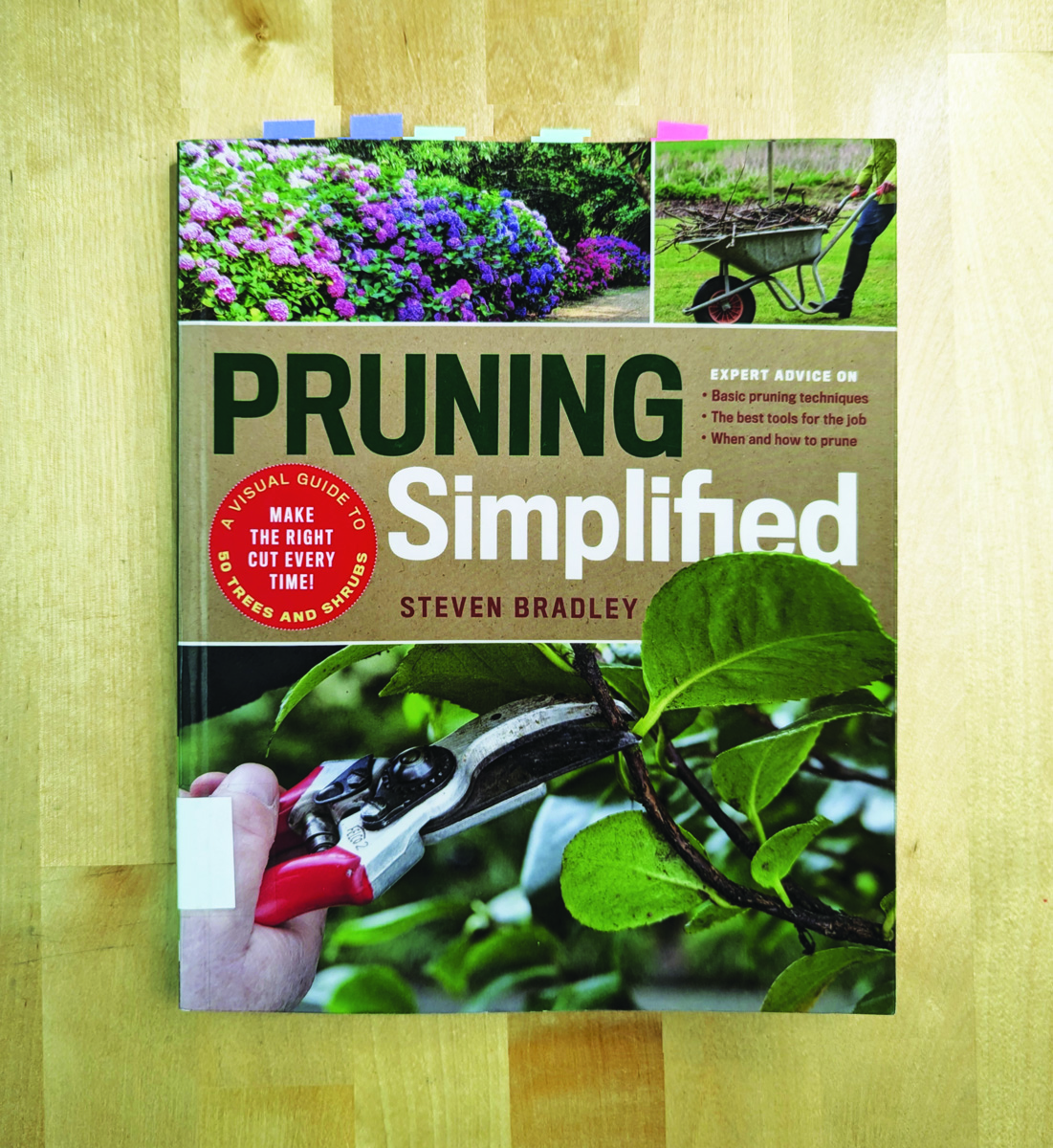
Pruning Simplified: A Step-by-Step Guide to 50 Popular Trees and Shrubs
Fine Gardening receives a commission for items purchased through links on this site, including Amazon Associates and other affiliate advertising programs.
Pruning Simplified shows you exactly how to do it. This must-have guide offers expert advice on the best tools for the job, specific details on when to prune, and clear instructions on how to prune. Profiles of the 50 most popular trees and shrubs—including azaleas, camellias, clematis, hydrangeas, and more—include illustrated, easy-to-follow instructions that will ensure you make the right cut the first time.
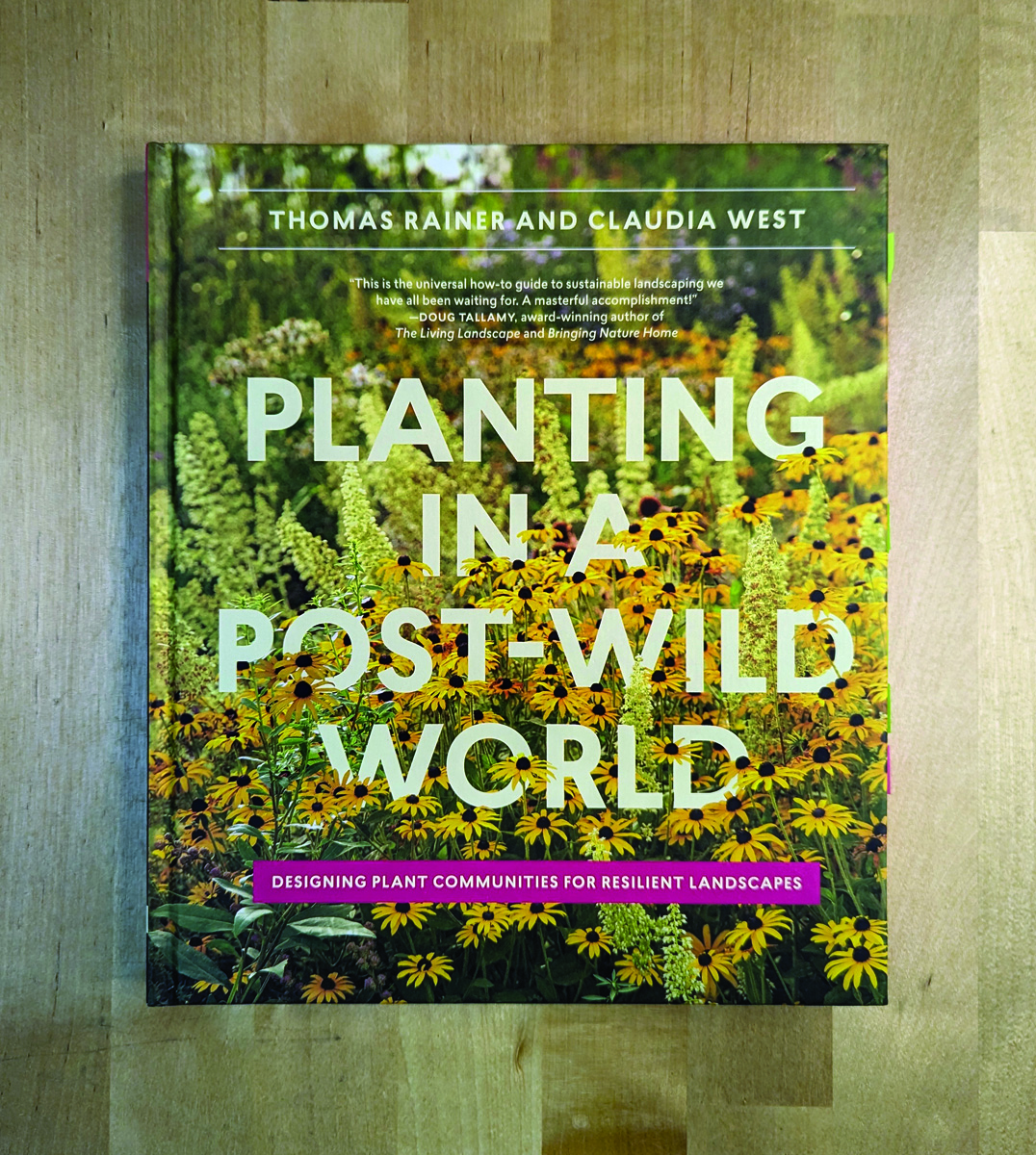
Planting in a Post-Wild World: Designing Plant Communities for Resilient Landscapes
Fine Gardening receives a commission for items purchased through links on this site, including Amazon Associates and other affiliate advertising programs.
Featuring gorgeous photography and advice for landscapers, Planting in a Post-Wild World by Thomas Rainer and Claudia West is dedicated to the idea of a new nature—a hybrid of both the wild and the cultivated—that can nourish in our cities and suburbs.
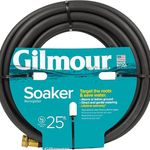
Gilmour 5/8″ x 25′ Round Weeper Soaker Hose
Fine Gardening receives a commission for items purchased through links on this site, including Amazon Associates and other affiliate advertising programs.
Lightweight garden hose is made of 100% recycled vinyl for clog resistant, consistent soaking in the garden or around foundations. Can be installed above or below ground to efficiently deliver water directly to plant roots. Can be linked with other hoses to create your own DIY garden drip irrigation system, and is flexible for easy storage and space saving.

